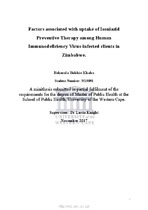| dc.description.abstract | BACKGROUND: HIV continues to be the single greatest risk factor for developing Tuberculosis
(TB) both globally and in sub-Saharan Africa. Zimbabwe is a country that has featured
prominently on lists developed by the World Health Organisation (WHO) of countries with a
high burden of HIV, of TB, and of TB among people living with HIV. The WHO has
developed normative guidance for helping to reduce the burden of TB among people living
with HIV, including Isoniazid Preventive Therapy (IPT). Zimbabwe adopted this policy in
2013 as a pilot that has since been rapidly rolled out nationally.
METHODOLOGY: This study is based on an analytical cross-sectional study done as a secondary
analysis of the electronic Patient Monitoring System (ePMS) data for HIV services currently
operational in selected facilities in the country. The overall aim of the study was to establish
the uptake of the IPT policy among IPT-eligible PLHIV at facilities with the ePMS. The
specific objectives were to establish the uptake of IPT among eligible PLHIV in Zimbabwe;
to identify patient factors associated with implementation of IPT; and to identify facility
factors associated with implementation of IPT. Data on 345,414 people living with HIV from
205 public health facilities across the country providing HIV services were extracted from the
ePMS to establish the uptake of IPT among eligible PLHIV. Bivariate analysis, followed by
simple binary and multivariable logistic regression analyses were used to identify both patient
and facility factors associated with uptake of IPT.
RESULTS: This study showed that uptake of IPT, across all of the 205 facilities implementing
IPT was 0.4%, due to the study being carried out soon after a rapid rollout of the programme.
The following patient factors were associated with uptake of IPT- age of 0- 14 years (AOR
0.16; 95% CI: 0.06-0.44); age 15- 19 years (AOR 0.23; 95% CI: 0.08- 0.63); age 20- 29 years
(AOR 0.62; 95% CI: 0.46-0.82); Not pregnant (AOR 2.50; 95% CI: 1.54- 4.00); WHO
Clinical Stage 1 and 2 (AOR 1.14; 95% CI:1.05-1.23); clients between 4 – 7 years since
enrolment into HIV care (AOR 1.21; 95% CI: 1.12-1.30); and clients that have been at least
eight years since enrolment into HIV care (AOR 1.32; 95% CI: 1.16-1.50). Facility factors
that were associated with IPT uptake, referral facility- secondary level or higher-(AOR 0.46;
95% CI: 0.43-0.51); facilities with HIV caseloads of less than 1000 patients in care (AOR
0.49; 95% CI: 0.44-0.54); facilities in Harare province (AOR 0.30; 95% CI: 0.26-0.34);
Manicaland (AOR 0.52; 95% CI: 0.43-0.63); Mashonaland Central (AOR 0.13; 95% CI:
0.10-0.18); Mashonaland East (AOR 0.71; 95% CI: 0.58-0.87); Masvingo (AOR 0.06; 95% CI: 0.04-0.08); Matabeleland South (AOR 0.07; 95% CI: 0.05-0.10); Midlands (AOR 0.68;
95% CI : 0.56-0.81); urban setting (AOR 1.66; 95% CI: 1.47-1.87)
CONCLUSION: Uptake of IPT is very low, partly due to inclusion of facilities that had only
recently begun implementing the IPT policy due to a phased approach to the rollout. In spite
of this, patient and facility factors identified in this study need to be used to target
interventions aimed at reducing the huge burden of TB on people living with HIV. Another
evaluation of this nature is recommended in future to assess the impact of any targeted
interventions identified through this study on IPT uptake. | |

